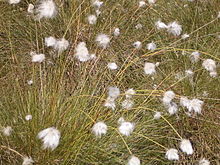Eriophorum vaginatum
| Hare's-tail cottongrass | |
|---|---|

| |
| Scientific classification | |
| Kingdom: | |
| (unranked): | |
| (unranked): | |
| (unranked): | |
| Order: | |
| Family: | |
| Genus: | |
| Species: | E. vaginatum
|
| Binomial name | |
| Eriophorum vaginatum | |
Eriophorum vaginatum L. (hare's-tail cottongrass,[1] tussock cottongrass, sheathed cottonsedge) is a species of perennial herbaceous flowering plant in the sedge family Cyperaceae. It is native to bogs and other acidic wetlands throughout the Holarctic Kingdom. It is a 30–60 cm high tussock-forming plant with erect solitary spikelets.
Description

E. vaginatum is a 30– to 60-cm-high tussock-forming plant. The inflorescence is a dense, tufted cyme with erect solitary, multiflowered spikelets.[2] It is rhizomatous, with leaves usually longer than the stem,[3] and the fruit is an achene. Each individual tussock comprises 300–600 tillers,[2] which contain two or three needle-like leaves enclosed in a sheath at the base. The density of tillers in a tussock depends both upon the diameter of the tussock (tiller density decreases as tussock diameter increases) and invasion by mosses and shrubs, factors which also affect tiller size and robustness of tiller production.[4]
Distribution and habitat

The arctic tussock tundra ecosystem is characterized by the dominance of Eriophorum spp., in particular E. vaginatum. This species has a circumboreal distribution and can be found throughout the British Isles (except in the southeast), the peaty tundras of Asia and North America, and the subarctic forest zones of Siberia and Western Canada.[3][2] Common in Scotland, it is sometimes referred to as draw-ling or drawmoss.[5][6]
References
- ^ "BSBI List 2007". Botanical Society of Britain and Ireland. Archived from the original (xls) on 2015-01-25. Retrieved 2014-10-17.
{{cite web}}: Unknown parameter|deadurl=ignored (|url-status=suggested) (help) - ^ a b c Howard, Janet L. (1993). "Eriophorum vaginatum". Fire Effects Information System (FEIS). US Department of Agriculture (USDA), Forest Service (USFS), Rocky Mountain Research Station, Fire Sciences Laboratory. Retrieved 24 February 2012.
- ^ a b Wein, R.W. (1973). Eriophorum vaginatum L. Journal of Ecology, 61, 601-615.
- ^ Fetcher, N. & Shaver, G.R. (1982). Growth and tillering patterns within tussocks of Eriophorum vaginatum. Holarctic Ecology, 5,180-186.
- ^ http://www.dsl.ac.uk/entry/snd/draw
- ^ Highlands and Islands, Darling and Boyd,Pub.Collins, The Fontana New Naturalist,1969.
